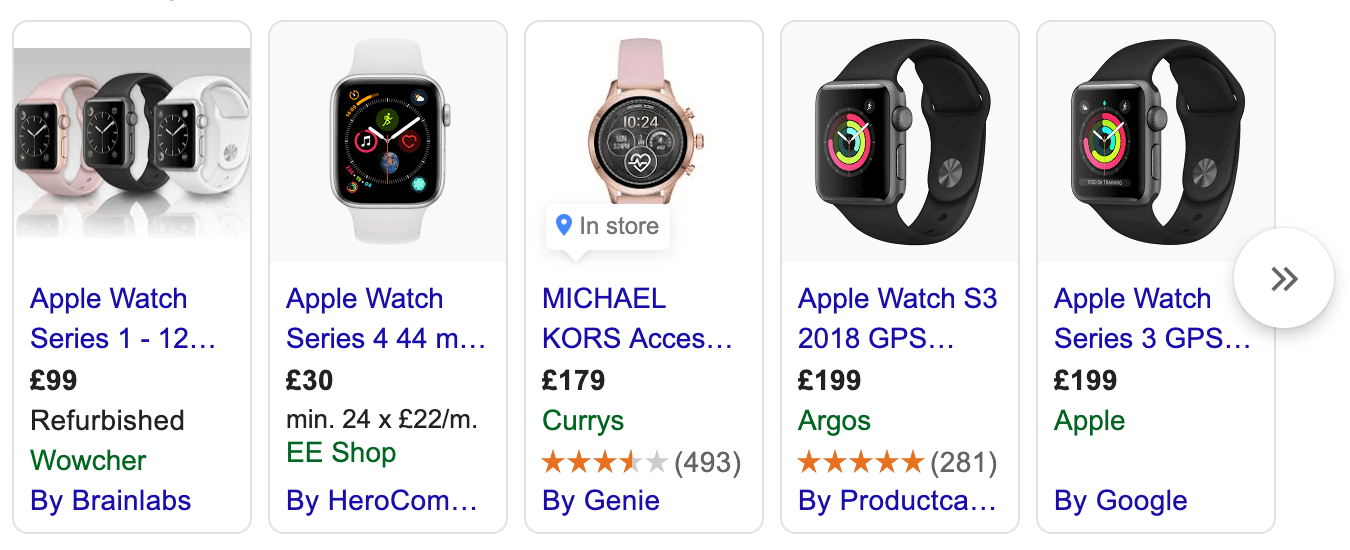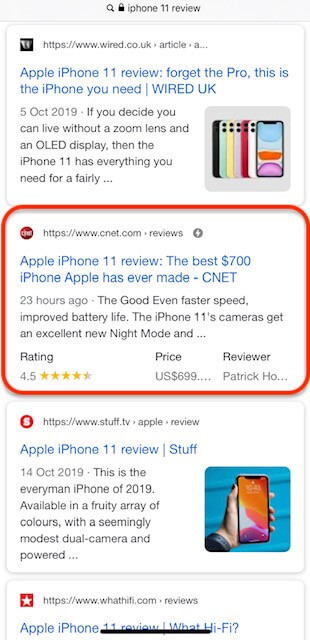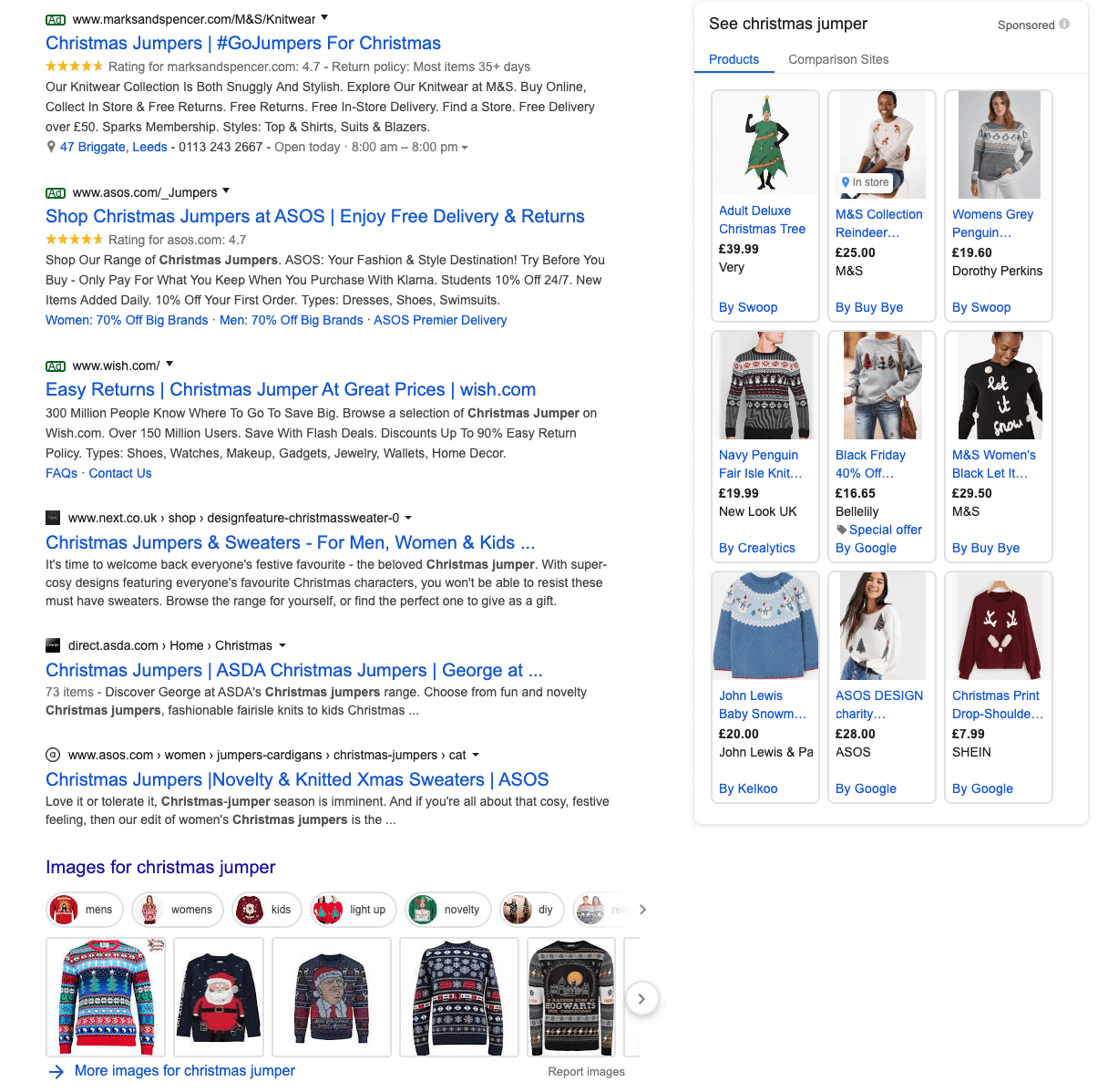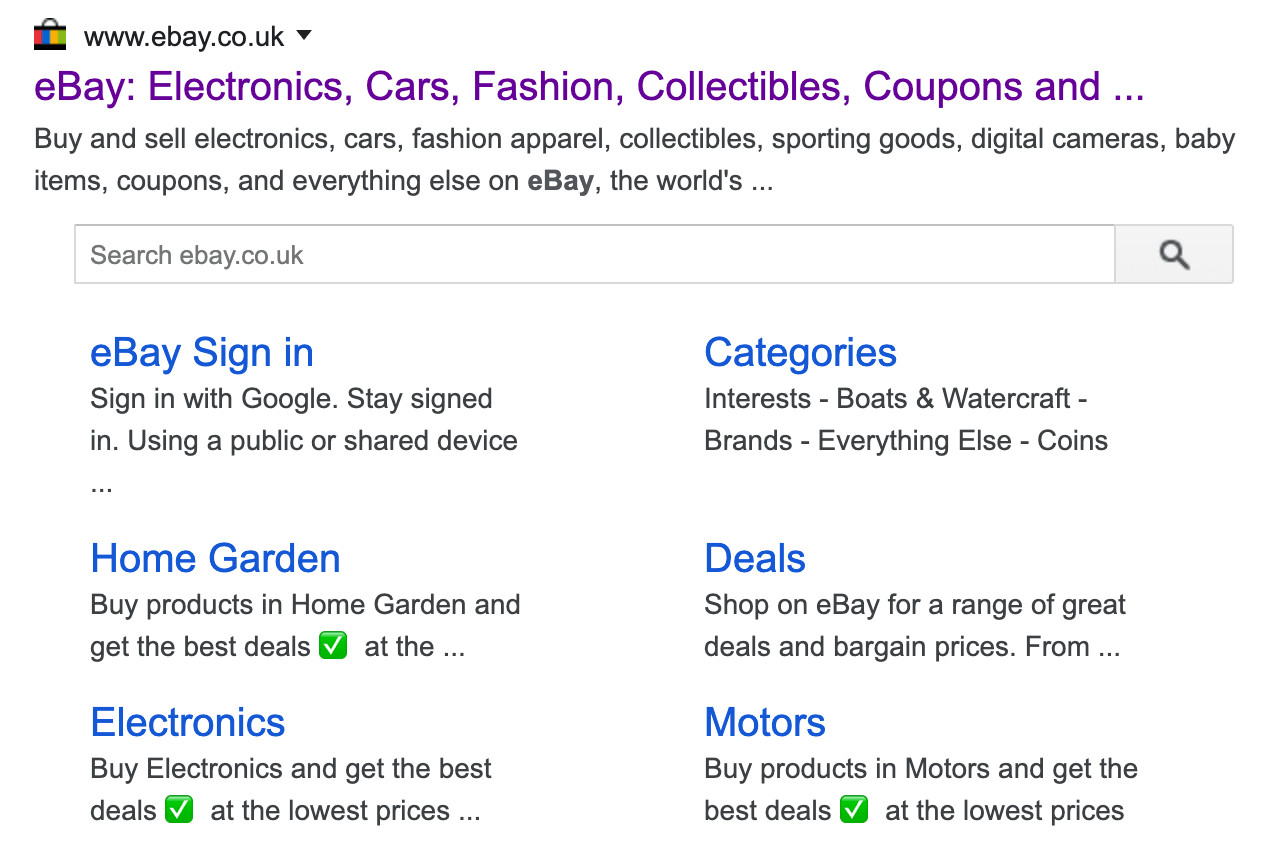Five rich snippet strategies for ecommerce sites
With Christmas just a couple of months away, many businesses are planning dedicated promotions and sales events in an effort to maximise their revenues over the next quarter.
Dedicated events such as Black Friday, Cyber Monday, and the Boxing Day sales are some of the busiest days for ecommerce, yet you can’t just turn up and hope to capitalise on potential customers.
However, ecommerce sales happen all year long and the peak sales months will vary from retailer to retailer.
A good eCommerce SEO strategy will have prepared your site so that you can be found at the top of the SERPs for when customers come ready to buy.
But how can you convince customers to make that final click to land on your site rather than your competitors? Using structured data for rich snippets can help.
What are rich snippets?
Rich Snippets are enhanced search results that appear on Google or Bing SERPs.
A typical search result will include a title tag, meta description and breadcrumbs.
A rich snippet will include additional features that provide extra information and relevancy to search engines and end-users.
An example of a standard search result is:

And there are many different types of rich snippets, some of the common ecommerce examples include:
Carousel:

Reviews:

Search Bar:

And the above maybe some of the most recognisable rich snippets, additional variations for commercial and non-commercial intent also include
- Authors
- People
- Prices
- Companies
- Events
- Organisations
- Music
- Videos
- Inventory
- Images
- Recipes
What Impact can rich snippets have?
Search results that are displayed as rich snippets as opposed to standard search results can definitely impact the visibility of your results.
Rich snippets contain more visual elements, including, but not limited to, star ratings, photos or video screenshots. The addition of the visual elements draws the attention of the search visitors to rich snippets results.
An example of this can be seen on page one of Google for the search “iPhone 11 Review” on both mobile and desktop devices. In the below examples, the rich snippet includes a star-rating, author and price details.

And this is even more impactful on mobile, where each result takes up a larger percentage of the screen:

Having search results that are impactful and attract attention are more likely to drive conversions from a search to a click.
Google has explicitly stated on multiple occasions that optimising content for rich snippets is NOT a ranking factor, they have said they are still keen for webmasters to implement structured data.
In 2017, Gary Illyes was quoted as saying:
…add structure data to your pages because during indexing, we will be able to better understand what your site is about.
It will help us understand your pages better, and indirectly, it leads to better ranks in some sense, because we can rank easier.
With that in mind, here’s five examples of how rich snippets can be implemented for ecommerce, how they work, and what the likely benefits are:
Five ecommerce strategies for rich snippets
When potential customers are in the buying phase, you need to convince them to complete their transaction with you rather than a competitor. Here’s five strategies that include optimising your ecommerce content for rich snippets:
High-quality images
Optimising images is an incredibly simple SEO task, but there are still businesses that are not making the most of it.
Look at this desktop SERP for “Christmas Jumper”.
This includes 14 high-quality images; five organic and nine sponsored images.

What do you notice between the sponsored and organic images?
The organic images lack models in their images and hence each of the photos feature more of the actual product in the image.
It doesn’t stop there though.
Looking at the sponsored images in more detail, there is also a lack of proper alt text for ALL nine sponsored image listings.
The alt text is missing or using something non-descript like “carousel image 0” instead.
Big brands are simply spending money to appear in ads, but not even competing in organic listings.
Images are now such a big part of rich snippets, so expect them to appear in as many different result types as possible.
Tips for product optimisation:
- Use descriptive alt text for all images. Make sure any plugins are not interfering with search engines ability to see this.
- Use clear, simple product images. Include only the necessary on a plain background as best as possible.
- Keep image filesizes to a minimum. Use modern image formats such as webp where possible.
Reviews
Amazon is undoubtedly the king of the ecommerce market, and they didn’t achieve this by accident.
In 1995, amazon first introduced public reviews to its product listings. A move that was met with surprise at the time, but over 20 years later is one of the key trust indicators for ecommerce shopping.
And as such, Amazon is now the experts at implementing review rich snippets for all sorts of products.
A list of random products that utilise this include:

Although the ratings are not included on all amazon listings, they are included on the majority of individual product pages, using on-page review data to populate the schema.
But using reviews is not exclusive to amazon; anybody can use it.
However, to use star rating schema, you need to manually include the data, the average rating, and the number of ratings received.
And this means using your own data, not copying amazon reviews or using third party review sites without consent of the data.
Tips for implementing reviews:
- Remember that anybody with a product page can use it.
- Reviews can only be used on product pages and not category pages.
- Likewise, never include reviews for your homepage.
- The data you use to represent your reviews must be unique data.
Pricing and offers
So, you’ve got to the top of the SERPs for a product that you have a great deal on (and lots of stock to sell!), how can you show potential customers that you have the best price? Include the structured data for product and offer alongside the page title and meta description.
An example is for “iPhone X” which includes a price and availability:

And when the product is unavailable, the rich snippet can be updated to show:

And although this seems counterintuitive to convince search visitors to not click on the product page, the result has additional site links – another rich snippet feature – that makes the most of a good search engine ranking for an old model.
This can then convince visitors to visit a newer product and convert on a different product that is in stock.
This may seem like a lot of effort, but it is a much better user experience for a customer who sees no rich snippet, makes a click to an out-of-stock product and bounces straight away in frustration.
Important to note; you need to include the availability structured data to be able to include the price.
Tips for implementing pricing and offer rich snippets:
- Use pricing and availability of rich snippets to add increase the amount of useful information available.
- Re-use listings for ‘old’ products and convert them to newer products.
- Add a sense of urgency by showing availability.
- Demonstrate multiple products available by including a price range for products.
Events
Are you an ecommerce site selling tickets for events rather than physical products? Well, you’re in luck; there’s a specific schema for you.

By including additional structured data about your events, what they are, where it’s located and information regarding pricing and availability, you are likely to see more rich snippets like this.
Results similar to the above are still likely to be found when visitors are looking specific events in certain cities, as it also increases your visibility for generic search terms like “events near me” or “events in London” for example.
Tips
- Event rich snippets can be used for both paid and free events.
- Including more information increases your chances of being found for more search terms.
- Don’t use this rich snippet for anything that isn’t a dedicated event.
Searchbar
If you have a site that receives a high volume of branded search traffic, you are likely to be a candidate for a sitelink search box.
An example of a search box is ebay.co.uk; where the search box is included amongst the more common site links:

Upon entering a search term and pressing submit, searchers are taken to a new search result page hosted on the brand domain and only features results on that domain name.
By using your brand name to your advantage, you can convince search visitors to enter your sales funnel with a search box rich snippet.
By getting visitors to commit to your site from their initial Google search, you are less likely to compete with third-party sellers of your own branded items or compete with affiliate sales, which effectively dilute your margin.
Sitelinks Tips
- If you generate a lot of branded search terms, you are likely to be a contender for the search bar rich snippet.
- Check your webmaster tools for messages from Google informing you of the availability of this feature for your own site.
- You can always opt out of this at any point if you see any negative effects on clicks or CTR.
Using Structured Data to implement Rich Snippets
In order to start optimising for rich snippets in the SERPs, you need to provide you data in the form of structured data.
This allows search engines to understand the context of the content and turns previously ambiguous data into clearly defined data. And when talking about structured data, there are two things of importance; markup and schema.
Markup refers to the structured data language used with examples including Microdata, JSON-LD and microformats.
And schema is the vocabulary that can turn this structured data into content that can be displayed as rich snippets.
What is Schema?
In 2011, the search engine teams at Google, Bing, Yahoo & Yandex got together to create Schema.org with the aim of creating a consistent and easy-to-use data markup tool.
The best explanation of Schema.org that I could find was from the schema.org site itself:
Schema.org provides a collection of shared vocabularies webmasters can use to mark up their pages in ways that can be understood by the major search engines: Google, Microsoft, Yandex and Yahoo!
Simply put, once you have picked which rich snippet(s) to optimise for, you just need to find the appropriate schema framework and complete the mark-up for each property.
It is possible to use one of two formats; microdata or JSON-LD to markup these results. Below are screenshots for the corresponding markup for the question ‘what is the return policy?’:
Microdata:
<html itemscope itemtype="https://schema.org/FAQPage"> <head> <title>Example Site - Frequently Asked Questions(FAQ)</title> </head> <body> <div itemscope itemprop="mainEntity" itemtype="https://schema.org/Question"> <h3 itemprop="name">What is the return policy?</h3> <div itemscope itemprop="acceptedAnswer" itemtype="https://schema.org/Answer"> <div itemprop="text"> <br /><p>Online purchases may be returned via a major parcel carrier. <a href="http://example.com/returns"> Click here </a> to initiate a return.</p> </div> </div> </div>
Most unopened items in new condition and returned within <strong>90 days</strong> will receive a refund or exchange. Some items have a modified return policy noted on the receipt or packing slip. Items that are opened or damaged or do not have a receipt may be denied a refund or exchange. Items purchased online or in-store may be returned to any store.
JSON-LD:
<html>
<head>
<title>Example Site - Frequently Asked Questions(FAQ)</title>
<script type="application/ld+json">
{
"@context": "https://schema.org",
"@type": "FAQPage",
"mainEntity": [{
"@type": "Question",
"name": "What is the return policy?",
"acceptedAnswer": {
"@type": "Answer",
"text": Most unopened items in new condition and returned within <strong>90 days</strong> will receive a refund or exchange. Some items have a modified return policy noted on the receipt or packing slip. Items that are opened or damaged or do not have a receipt may be denied a refund or exchange. Items purchased online or in-store may be returned to any store.<br /><p>Online purchases may be returned via a major parcel carrier. <a href=http://example.com/returns> Click here </a> to initiate a return.</p>"}
Both provide exactly the same information and are both as likely to be shown as a rich snippet — but which one is recommended to implement?
What is Microdata?
Microdata is HTML semantic mark-up which at its most basic level nests metadata within content on webpages. Using microdata allows properties to be applied to item types which contain multiple attributes.
Hence, this allows web browsers to extract additional information from webpages, which in turn provides more information to search engines and results in greater relevance for organic search visitors.
What is JSON-LD?
JSON-LD, which is short for “JavaScript Object Notation – Linked Data”, is similar to microdata, in that it allows you to assign data to properties and item types.
However, because it is a script element rather, it allows greater flexibility during implementation; allowing it to be placed in the head section with other metadata, or even in the body tag.
Which one should I use?
Although Google has said that using both forms of markup data is fine for Schema, Google has explicitly stated that JSON-LD is the recommended format.
However, in the interest of making things easier for webmasters, JSON-LD is also recommended to implement and maintain across a site.
Because microdata must be added in line with HTML, this makes the process incredibly manual, which is not only time-consuming, but prone to mistakes.
On the other hand, JSON-LD can be added across many pages at the same time. This makes it easier to add, modify or remove in the future.
How to Implement Structured Data on Your Site
Once you’ve decided which rich snippet(s) you wish to optimise your content for, you just need to choose the right schema type.
Depending on the CMS that you are using for your website, the options available to you vary. For example, WordPress has a multitude of plugins that can implement schema relatively easily across single or multiple pages.
However, if you are using a CMS like Magento and are implementing schema across your site for the first time, this will require the involvement of a developer to help you set this up.
Regardless of how you are setting up your schema, it is recommended that you always check the implementation of your schema.
How to Test your Data Implementation
Testing your schema implementation is an easy enough task thanks to a structured data testing tool made available by Google.
You can use the structured data testing tool to check that your schema has been set up correctly; to ensure it is mistake-free and you have filled in all the required fields. Simply copy and paste your URL into the tool and detected schema will identify the number of valid items with the number of errors or warnings present.
Alternatively, you can use the tool to check what your competitors are doing. This can give you insight into what competitors are optimising their content for and make any strategy decisions based on this.
Conclusion
Even though you may have a brilliant SEO strategy that has taken your best landing pages to the top of the SERPs for your industry related keywords, you still need to convince customers to click on your listings.
Planning and implementing a strategy for rich snippets can vastly improve your CTR by giving your search listings more visual elements and by taking up more visible space, hence minimising the amount of room your competitors can get alongside you.
Most product listings are vastly under optimised, so have you seriously considered your rich snippet opportunities to make the most of the sale events coming up soon and in the future?